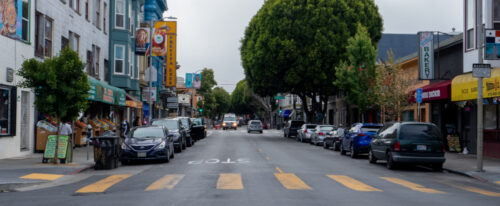The Mission–In The Midst Of The COVID-19 Pandemic

By Liz Lopez
Summertime in The Mission was quiet. Boarded up stores, locked up parks and empty streets appeared to be in stark contrast to this typically crowded, vivacious district. COVID-19 drastically altered the landscape of this district and it is marked by the struggles of businesses, residents and the community at large.
On the surface the tone of The Mission appeared to be one of resilience and cautious optimism. Some residents voiced their excitement about the reopening of the city but diving deeper, you heard authentic concerns for safety, worry over financial burdens and the longing for interaction with their community. Desperate for some semblance of normalcy, residents relied on local restaurants and venues to provide an escape from home-cooked meals, zoom fatigue, and isolation.
Summer-Three Months Post Shelter-In-Place, Small Businesses Struggle to Survive
David Quinby, the owner of Amados said,”When the shelter-in-place order happened, the Mission immediately became a ghost town. Small businesses did a great thing and shut down but many will never come back because of the financial devastation. The larger corporations have the luxury to shelter in place for months, even years, and work from a laptop. The working class and small businesses don’t have that luxury. I think that with the right preventive measures in place–masks, social distancing, washing hands–most risks can be mediated.”
Dolly Valdez Bautista, manager of Hawker Fare restaurant, expressed deep concerns for her employees and the San Francisco community at large. Bautista remarked, “If I close down, then all these employees don’t have jobs. This economic pandemic is going to be the worst one that we’re going to see. There are people who are three, four months behind on rent, and on top of that, are trying to figure out how to feed their families; so it’s definitely not over.”
“I think we should be holding the government accountable. If they really are concerned about the economy, then they should be subsidizing the mom and pop stores and small businesses, like they were supposed to, instead of this phantom money that is not even being accounted for,” commented Miriam Mendoza-Moody, a Mission District resident. The National Restaurant Association released a survey citing that 89% of adults expressed concern for businesses in their community that might not be able to survive the economic fallout from the COVID-19 pandemic.
Fall—Seven Months Post Shelter-In-Place, Over Half of SF Businesses Close
As fall progresses, residents that are working from home, who don’t risk being evicted, are the most optimistic about the future. Those who were laid off and are behind on rent are most apprehensive about staying healthy, finding a job, and providing for their families.
Restaurants in San Francisco currently are allowed to serve customers indoors, up to 25% of capacity; however, with such narrow profit margins, in an industry that hands over a large portion of their profits to third-party delivery companies, more closures are sure to come. Without government aid many businesses may not survive. Businesses located within college campuses have a unique set of obstacles, as they do not have keys to their own businesses and their customer base (on-campus students) is currently non-existent.
“If there are no students, there’s no business,” says Alberto Campos, owner of Cafe de la Mission, located at 1125 Valencia Street, within the City College Mission Center. Whether or not college campuses open their doors to students next semester is of paramount concern to businesses located on college campuses. Prior to the COVID-19 campus closure, Campos was gradually investing in inventory for his restaurant, but post-closure and with no sales, Campos must reassess his inventory and sell perishable merchandise at a loss.
With temporary closures turning into permanent closures across the Bay Area, many restaurant owners found that restructuring their business for take-out orders or outdoor dining was not an across-the-board solution. KPIX reported on survey results released by the San Francisco Chamber of Commerce, which revealed that more than half of all storefronts in San Francisco have closed since the onset of the COVID-19 pandemic. The full economic fallout from the COVID-19 pandemic and the future of local small businesses is uncertain at this time.
